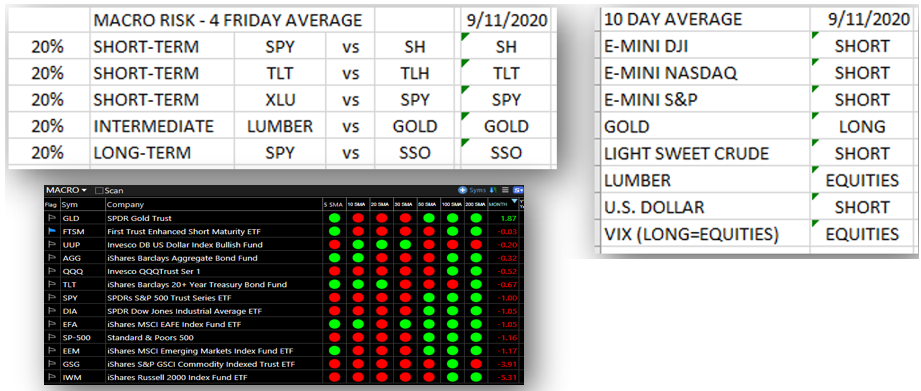Fast two-week market drop as V recovery fades… Pessimistic reports on the economy, employment and vaccine progress resulted in investors shedding positions to capture profits and protect capital.
What it means— Selling recently has accelerated to levels similar to the February peak. The 50-day simple moving average, a key technical benchmark, was penetrated Friday by the S&P-500 and the NASDAQ closing below it and other similar indicators.
We track market health using a variety data points using daily, weekly and monthly time frames. Friday’s data resulted in this:

The “traffic light chart” became decidedly defensive or “risk off.” The tables were mixed indicating investor uncertainty and possible topping.
This morning, weekend news of major merger activity encouraged investors, and the market gapped up at the open. However, as often happens on Mondays, sellers gained control early and resumed selling. Few of our charts are exhibiting sufficient trend to suggest a move back to previous highs. Historically September is, after all, the most volatile month.
Jobless Claims Rise as Employment Stalls… Initial state unemployment claims remained steady at 884,000, while all continuing claims rose 380,000 to 29.6 million.
What it means— Investors expected initial unemployment claims to fall by 40,000 or so, but instead they remained constant, whereas continuing claims, which are reported on a two-week lag, rose by almost 400,000.
That’s not the right direction. As pointed out last week, the numbers have many caveats, including seasonal adjustments on initial claims and the fact that continuing claims include groups such as gig workers and the self-employed under the new federal Pandemic Unemployment Assistance.
Because that program is new, we don’t have historical data that shows how it might ebb and flow. But if we step back a bit and look at the big picture, it’s obvious that people are still losing their jobs in historically high numbers, and we’ve reached a plateau in putting people back to work, which brings up a question. Is it structural?
Many people are losing retail jobs, and yet small manufacturers are claiming they cannot get applicants. It is possible that we’re going through a restructuring of the economy that leaves potential employees geographically disconnected from job opportunities? Many people might need to leave big cities to find their next opportunity.
Consumer Prices Rose 0.4% Last Month… CPI increased 1.4% over last year and core inflation rose 1.7% over 2019.
What it means— Prices rose a bit faster than expected last month, and those gains occurred after inflation rose 0.6% in both June and July. Inflation is still running lower than at the beginning of the year when the headline number was 2.5%. So, we’re still playing catch up. With overnight interest rates at zero and the 10-year bond yielding about 0.7%, real interest rates are now running significantly below zero. This is only the beginning. Per the Federal Reserve, we can look forward to negative real rates for years to come.
Inside of the inflation data, prices for used cars and trucks jumped 5.4% last month, due to lack of inventory for either new or used vehicles. It was the largest price increase since 1969.
On the flip side, education prices dropped 0.3%. While that might sound miniscule, consider that it’s the first time that education prices have dropped… ever. The data series only goes back to 1993, but that’s still 27 years. Could this be the start of something good in education? Can the coronavirus do what decades of angry op-eds and parents upset about the cost of education couldn’t? It’s too early to tell, but it sure is nice to think about.
Tesla Down More Than 35% After Being Snubbed by S&P… The committee that determines which stocks will be included in the company’s 500-stock index decided not to include Tesla. Investors who had bought shares in anticipation of it joining the index sold their shares, driving the stock lower.
What it means— For a minute, Elon Musk was the third-richest man in the world, and then Standard and Poor’s relieved him of about one third of his wealth. Investors had snapped up Tesla shares in the weeks leading up to the company’s stock split, which happened just before S&P reconfigured its widely followed 500-stock index. The stock soared as investors anticipated all the good news, but they were sorely disappointed when S&P took a pass. To make things worse, S&P included Etsy, the online marketplace famous for bringing homemade jewelry and other craft items to consumers, in the index ahead of the best-known electric vehicle company in the world.
But don’t feel too bad for Musk; his stock, and therefore his net worth, is still up by more than 400% for the year.
Wife Tells Husband to Buy Garden Gnome, Instead He Buys 12-Foot T-Rex… Who hasn’t made this mistake? You get sent to the store for one thing, but get to thinking how much better it would be if you bought something different. Right?
Englishman Adrian Shaw’s wife Deborah asked him to clean up the little garden in the back of their patio home and even suggested that he add a garden gnome.
After considering it, Adrian thought he could make the space even better by adding a very lifelike 12-foot Tyrannosaurus Rex. It set him back around $2,000, but, hey, it was worth it. He had the creature installed while his wife was out for the day. It took a crane to get it into the small yard, where it now ominously peeks out from behind some bushes.
Shaw figured his wife, also a fan of the Jurassic Park movies, would be thrilled. Instead, she let the dog out in the middle of the night and was scared to death.
Deborah’s not as happy with the creature as Adrian is, but he says it’s not going anywhere.
What it means— Apparently, no one ever told Adrian. “Happy wife. Happy life.”

